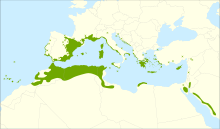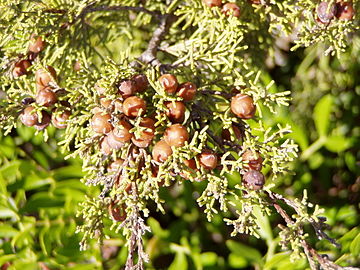| This article's factual accuracy may be compromised due to out-of-date information. The reason given is: Juniperus turbinata and J. canariensis have been split off. Relevant discussion may be found on the talk page. Please help update this article to reflect recent events or newly available information. (January 2018) |
| Juniperus phoenicea | |
|---|---|

| |
| Specimen from Roussillon, France | |
| Conservation status | |
 Least Concern (IUCN 3.1) | |
| Scientific classification | |
| Kingdom: | Plantae |
| Clade: | Tracheophytes |
| Clade: | Gymnospermae |
| Division: | Pinophyta |
| Class: | Pinopsida |
| Order: | Cupressales |
| Family: | Cupressaceae |
| Genus: | Juniperus |
| Section: | Juniperus sect. Sabina |
| Species: | J. phoenicea |
| Binomial name | |
| Juniperus phoenicea L. | |

| |
| Natural range | |
| Synonyms | |
| |
Juniperus phoenicea, the Phoenicean juniper or Arâr, is a juniper found throughout the Mediterranean region.
Description
Juniperus phoenicea is a large evergreen shrub or small tree reaching 5–8 metres (16–26 feet) tall, with a trunk up to 1–2 m (3+1⁄2–6+1⁄2 ft) in diameter and a rounded or irregular crown. The bark, which can be peeled in strips, is dark grayish-brown. The leaves are of two forms, juvenile needle-like leaves 5–14 millimetres (1⁄4–1⁄2 in) long and 1 mm wide on seedlings, and adult scale-leaves 1–2 mm long on older plants with a green to blue-green color; they are arranged in opposite decussate pairs or whorls of three. It is largely monoecious, but some individual plants are dioecious. The female cones are berrylike, 6–14 mm in diameter, orange-brown, occasionally with a pinkish waxy bloom, and contain 3–8 seeds; they are mature in about 18 months, and are mainly dispersed by birds. The male cones are 2–4 mm long, and shed their pollen in early spring, which is then dispersed by wind.
-
Trunk bark
-
 Unripe berries
Unripe berries
-
 Foliage and ripe berries
Foliage and ripe berries
-
 Isolated foliage and berries (Muséum de Toulouse)
Isolated foliage and berries (Muséum de Toulouse)
Taxonomy
There are two varieties, treated as subspecies by some authors and as separate species by others:
- Juniperus phoenicea var. phoenicea = J. phoenicea. Throughout the range of the species. Cones globose, about as wide as long. Leaves are small and obtuse. Sheds pollen in the spring.
- Juniperus phoenicea var. turbinata (syn. Juniperus turbinata). Confined to coastal sand dune habitats. Cones oval, narrower than long. Leaves are long and thin. Sheds pollen in the autumn.
Distribution and habitat
The species is found throughout the Mediterranean region, from Morocco and Portugal east to Croatia, Italy, Turkey, and Lebanon. It also grows in Egypt, the Palestine region and in western Saudi Arabia near the Red Sea, and also on Madeira and the Canary Islands. It mostly grows at low altitudes close to the coast, but reaches an altitude of 2,400 m (7,900 ft) in the south of its range in the Atlas Mountains.
Ecology
The species prefers a hot, arid climate with a lot of light, and grows on rocky or sandy ground. Its preferred soil is calcareous with a pH between 7.7 and 7.9 (moderately basic), but could also be silicate. Despite having a shallow root system, it can survive with as little as 200 mm (8 in) of rain per year. It can often be found forming scrubs and thickets with other species. In its natural range of France and Spain, J. phoenicea has a generational life of 25 years, and is considered a stable species on the 2016 IUCN Red List of Threatened Species.
Its habitat in coastal areas is most threatened by the presence of humans, both settled and touring. Humans also plant not-naturally-present plants such as pines, black locust, French tamarisk, desert false Indigo, American agave, tree of heaven, and some succulent plants from South Africa. The purpose of this is usually to stabilize the dunes, but these outside plants interfere with the natural vegetation. It is also threatened easily by fires, because it is quite flammable and does not regenerate well. This makes it necessary to plant new organisms after a fire has damaged the others.
Uses
Further information: Juniper berryJuniper berries are used as a seasoning in cooking or in alcoholic beverages, particularly to flavor gin. Juniper berries have also been used in traditional medicine for different conditions, although there is no high-quality clinical evidence that it has any effect. Although extracts of juniper berries or wood tar have been used as an aroma – particularly for cosmetics – the safety of using ointments manufactured from J. phoenicea and related species has not been adequately demonstrated, according to a 2001 review. Juniper extracts used topically may cause skin allergic reactions, and should be avoided during pregnancy.
The tree's essential oil is especially rich in the tricyclic sesquiterpene thujopsene. The heartwood contains an estimated 2.2% of thujopsene; this explains the superior natural durability of the wood itself. The biochemist Jarl Runeburg noted in 1960 that J. phoenicea appears to be the most convenient source of thujopsene so far encountered." Juniper wood is used for small manufactured objects and inlay works in carpentry, and in building construction in Africa where it is mainly used for fuel and producing charcoal.
Culture
It is the vegetable symbol of the island of El Hierro.
See also
References
- ^ Allen, D.J. (2017). "Juniperus phoenicea". IUCN Red List of Threatened Species. 2017: e.T16348983A99965052. doi:10.2305/IUCN.UK.2017-2.RLTS.T16348983A99965052.en. Retrieved 19 November 2021.
- The Plant List: A Working List of All Plant Species, retrieved 11 February 2017
- ambiguous Arabic name also given to Tetraclinis articulata
- "Juniperus turbinata". World Checklist of Selected Plant Families. Royal Botanic Gardens, Kew. Retrieved 2018-01-28.
- ^ Runeberg, Jarl; Gramstad, Thor; Larsson, Lennart; Dodson, R. M. (1960). "The Chemistry of the Natural Order Cupressales. XXXI. Heartwood Constituents of Juniperus phoenicea L." Acta Chemica Scandinavica. 14: 1995–8. doi:10.3891/acta.chem.scand.14-1995.
- ^ Caudullo, G.; de Rigo, D. (2016). "Juniperus phoenicea in Europe: distribution, habitat, usage and threats" (PDF). European Atlas of Forest Tree Species. European Commission.
- Kabiel, Hanan F.; Hegazy, Ahmad K.; Lovett-Doust, Lesley; Al-Rowaily, Saud L.; Al Borki, Abd El-Nasser S. (2016). "Ecological assessment of populations of Juniperus phoenicea L. In the Al-Akhdar mountainous landscape of Libya" (PDF). Arid Land Research and Management. 30 (3): 269–89. doi:10.1080/15324982.2015.1090499. S2CID 130032990.
- ^ "Juniper". Drugs.com. 2018. Retrieved 22 February 2019.
- Cornish, Chloe (19 November 2021). ""In tumultuous Lebanon, a bright spot in . . . gin-making"". The Financial Times. Archived from the original on 2021-11-20. Retrieved 1 August 2021.
- "Final report on the safety assessment of Juniperus communis extract, Juniperus oxycedrus extract, Juniperus oxycedrus tar, Juniperus phoenicea extract, and Juniperus virginiana extract". International Journal of Toxicology. 20 Suppl 2 (2): 41–56. 2001. doi:10.1080/10915810160233758. ISSN 1091-5818. PMID 11558640. S2CID 40114722.
- "Pubchem Compound Database; CID 442402: Thujopsene". Pubchem, National Center for Biotechnology Information, US National Library of Medicine. 16 February 2019. Retrieved 22 February 2019.
- Lykidis, Charalampos; Bak, Miklos; Mantanis, George I. (2024-01-02). "Biological resistance of Phoenician juniper wood". Wood Material Science & Engineering. 19 (1): 1–5. doi:10.1080/17480272.2023.2221657. ISSN 1748-0272.
- Símbolos de la naturaleza para las Islas Canarias [Natural Symbols for the Canary Islands] (Ley 7/1991) (in Spanish). Vol. 151. 30 April 1991. pp. 20946–20497 – via BOE.
External links
 Media related to Juniperus phoenicea at Wikimedia Commons
Media related to Juniperus phoenicea at Wikimedia Commons
| Taxon identifiers | |
|---|---|
| Juniperus phoenicea |
|
- IUCN Red List least concern species
- Juniperus
- Flora of North Africa
- Flora of Southeastern Europe
- Flora of Southwestern Europe
- Flora of Western Asia
- Flora of the Canary Islands
- Plants described in 1753
- Taxa named by Carl Linnaeus
- Taxa named by Aimé Bonpland
- Taxa named by Alexander von Humboldt
- Flora of the Mediterranean basin